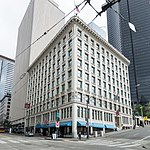Rector Hotel

The Rector Hotel, later known as the St. Charles Hotel and during the 1930s the Governor Hotel, is a historic hotel building located at the Southwest corner of Third Avenue and Cherry Street in downtown Seattle, Washington. It was constructed in the latter half of 1911 by the estate of pioneer lumber baron Amos Brown. Designed by prominent Seattle architect John Graham, Sr., the original plans were for a twelve-story building that would be built in two phases but the top 6 floors were never added. Originally a hotel serving the tourist trade, by the 1970s it was operating as a Single resident occupancy hotel. In 1986 it was renovated into low-income housing by the Plymouth Housing Group. In 2002 it was added to the National Register of Historic Places.It is located north of historic Pioneer Square, "in the shadow of" the Smith Tower, and adjacent to the former Grand Opera House and the 1910-built Chicago School-style Lyon Building, also designed by John Graham.
Excerpt from the Wikipedia article Rector Hotel (License: CC BY-SA 3.0, Authors, Images).Rector Hotel
4th Avenue Cycletrack, Seattle International District/Chinatown
Geographical coordinates (GPS) Address Nearby Places Show on map
Geographical coordinates (GPS)
| Latitude | Longitude |
|---|---|
| N 47.603333333333 ° | E -122.33083333333 ° |
Address
4th Avenue Cycletrack
4th Avenue Cycletrack
98164 Seattle, International District/Chinatown
Washington, United States
Open on Google Maps









